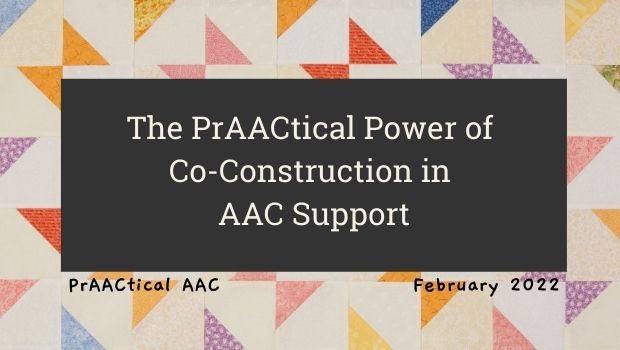The PrAACtical Power of Co-Construction in AAC Support

Independence is so highly valued in our society that the contributions of interdependence often get overlooked. Today, we’ll dive into an approach to AAC support that doesn’t always get the recognition it deserves.
Co-construction
In a general sense, co-construction is a collaborative process where two or more parties work together to build or create something. When this is applied to teaching and learning, co-constructive approaches feature collaborations, partnerships, coordination, and cooperation. With young children, for example, we co-construct meaning by having sustained interactions in contexts where they feel respected and secure in their sense of agency. We play a supportive role in their play, activities of daily living, and formal learning experiences by…
In the world of language, co-construction has a more specific meaning. Linguists use the term to indicate a single syntactic entity developed jointly within a conversation. In discourse, co-construction happens when sentences are built collaboratively by two or more people. For example, when Davis is reading to his toddler son and they encounter illustrations of words that little DJ knows, he elicits those words with sentence starters and weaves DJ’s response into the narrative.
- Dad: Little Bear is holding something, isn’t he? He’s got some ___.
- Child: Bubbles
- Dad: Yeah, Little Bear loves to blow bubbles.
- Child: Me
- Dad: That’s right. You love blowing bubbles, too.
Co-constructions are used frequently when young children are first learning language so that they can learn from our interaction and gain insight into the complexities of morphology, syntax, and semantics. Here’s an example of one type of co-construction, expansions.
- Parent: How did the all your stuffies get so wet?
- Maia: They messy ‘cuz Jeeter muddy them.
- Parent: Yeah, Jeeter took them outside in the garden. Jeeter always finds the mud, doesn’t he? Poor stuffies! They got pretty dirty.
- Maia: Stuffies has bath time.
- Parent: Oh, they needed a bath. So you put them in the potty to wash them?
In interactions like these, co-constructions allow children to pick up on the rules and conventions of language by giving them an active part of the process. Together, they are building meaning in a context that helps Maia develop a deeper understanding of the conventions of language.
In AAC, too, co-construction implies teamwork between the AAC learner and their communication partner. Their discourse reflects the contributions of each person as they collaborate to build meaning. In one respect, this is like what we’ve just discussed in interactions where both parties communicate through spoken language.
AAC has other uses of co-construction, as well. It is baked into some of the commonly used AAC strategies and approaches, such as partner-assisted scanning (PAS) and PODD. PAS requires the active participation of both parties in creating a message that expresses a thought or idea. The speaking partner serves as the ‘scanner,’ moving through the options and carefully observing the partner with AAC needs. When the AAC user demonstrates a signal that indicates which option they prefer and it is acknowledged by their speaking partner, the pair has co-created a message.
Expansions and extensions are ways that we often use co-construction AAC. We can use them to improve sentence-building, enhance conversations, and support the development of stories and narratives.
Independence isn’t always the goal in supporting the communication of people with AAC needs. Autonomy, on the other hand, always plays a central role in the provision of meaningful, respectful, and effective AAC support.
Do you have thoughts on the role of co-construction in AAC? We’d love to hear them.
Filed under: Featured Posts, PrAACtical Thinking
This post was written by Carole Zangari
